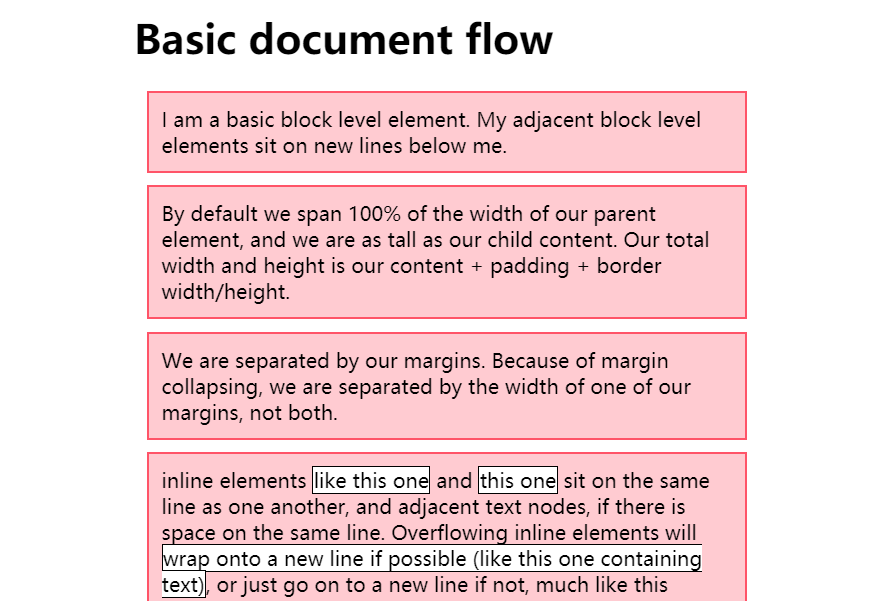正常布局流
默认情况下,元素是如何布局的?
首先,取得元素的内容来放在一个独立的元素盒子中,然后在其周边加上内边距、边框和外边距 --- 就是我们之前看到的盒子模型。
默认的,一个块级元素的内容宽度是其父元素的100%,其高度与其内容高度一致。内联元素的height width与内容一致。你无法设置内联元素的height width --- 它们就那样置于块级元素的内容里。 如果你想控制内联元素的尺寸,你需要为元素设置display: block; (或者,display: inline-block; inline-block 混合了inline 和 block的特性。)
这样解释了独立元素的布局,但是元素之间又是如何相互影响的呢? 正常布局流(在布局介绍里提到过)是一套在浏览器视口内放置、组织元素的系统。默认的,块级元素按照基于其父元素的书写顺序(默认值: horizontal-tb)的块流动方向(block flow direction)放置 --- 每个块级元素会在上一个元素下面另起一行,它们会被设置好的margin 分隔。在英语,或者其他水平书写、自上而下模式里,块级元素是垂直组织的。
内联元素的表现有所不同 --- 它们不会另起一行;只要在其父级块级元素的宽度内有足够的空间,它们与其他内联元素、相邻的文本内容(或者被包裹的)被安排在同一行。如果空间不够,溢出的文本或元素将移到新的一行。
如果两个相邻的元素都设置了margin 并且两个margin有重叠,那么更大的设置会被保留,小的则会消失 --- 这被称为外边距叠加,我们之前见到过。
我们来看一个对全部这些做出解释的简单例子:

<h1>Basic document flow</h1> <p>I am a basic block level element. My adjacent block level elements sit on new lines below me.</p> <p>By default we span 100% of the width of our parent element, and we are as tall as our child content. Our total width and height is our content + padding + border width/height.</p> <p>We are separated by our margins. Because of margin collapsing, we are separated by the width of one of our margins, not both.</p> <p>inline elements <span>like this one</span> and <span>this one</span> sit on the same line as one another, and adjacent text nodes, if there is space on the same line. Overflowing inline elements will <span>wrap onto a new line if possible (like this one containing text)</span>, or just go on to a new line if not, much like this image will do: <img src="https://mdn.mozillademos.org/files/13360/long.jpg"></p>
body { width: 500px; margin: 0 auto; } p { background: rgba(255,84,104,0.3); border: 2px solid rgb(255,84,104); padding: 10px; margin: 10px; } span { background: white; border: 1px solid black; }







